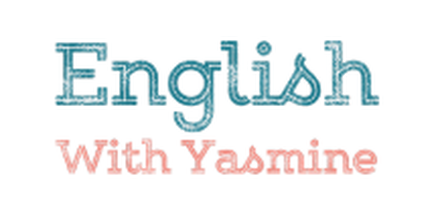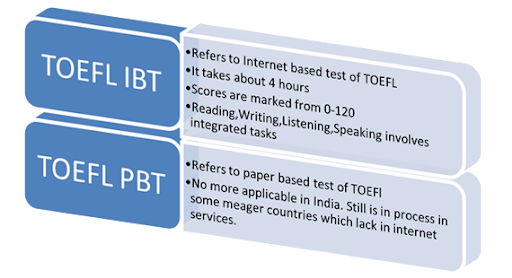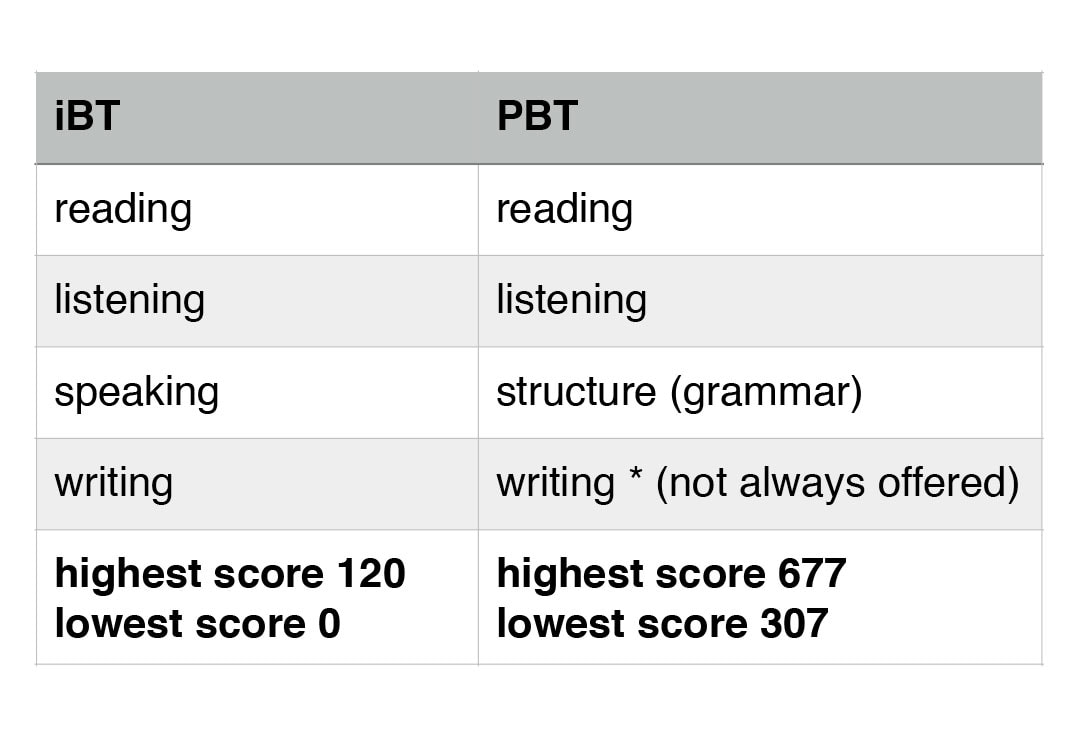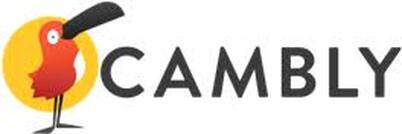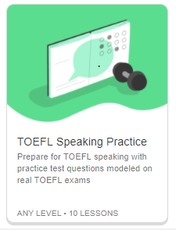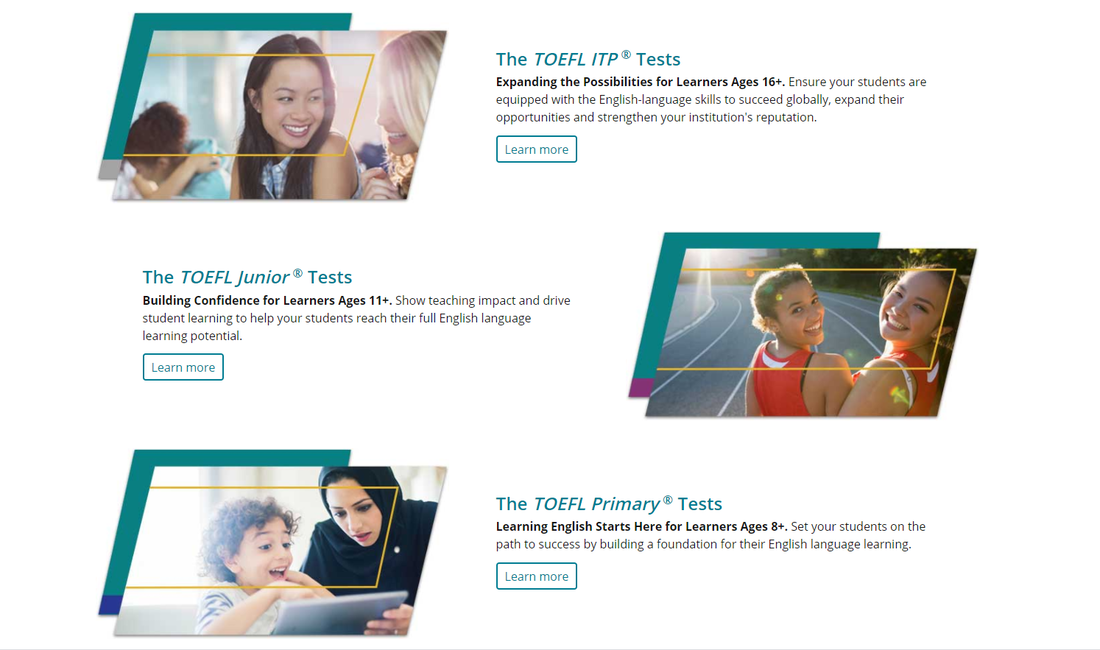|
I have taught many hours of TOEFL classes (both paper and Internet based tests).
To do well in TOEFL you need to:
In-person classes are normally 40-50 hours of classroom instruction; but times have changed. You can now study online with some really amazing presenters. I will list some of my choices below. |
Links for studying for TOEFL
1. Cambly's speaking test practice
Cambly is a great place to practice for the speaking portion of the IELTS exam. Just ask your tutor to bring up a lesson and begin.
2. ETS TOEFL Website
The TOEFL Paper-Based Test format and basics
TOEFL PBT Sections Overview
The TOEFL paper-based test (PBT) is a four-section assessment that is offered in places where the TOEFL internet-based test (iBT) is not available. The PBT is taken by just 3% of students who choose the TOEFL for their English-language requirements. Many colleges and universities will still accept PBT scores, but some will consider the iBT only. The PBT evaluates reading, listening, and writing skills along with knowledge of English conventions through four test sections: listening comprehension, structure and written expression, reading comprehension, and the Test of Written English. Total timing for the PBT is 140-150 minutes, which includes 140 questions and one essay topic.
The Listening Comprehension Section of the TOEFL PBT
According to ETS, the PBT's listening comprehension section is intended to "measure the ability to understand spoken English." Test-takers are given 30-40 minutes to answer 50 questions. The questions in this section are all multiple choice, and they are based on audio recordings of conversations and lectures. Correct answers are converted to a scaled listening comprehension section score of 31 to 68.
The Structure and Written Expression Section of the TOEFL PBT
The structure and written expression section of the PBT "measures the ability to recognize language appropriate for standard written English," and it covers 40 questions in 25 minutes. Structure and written expression questions are also multiple choice. Two types of exercises are included: questions in which test-takers must complete sentences with the best word choice, and questions that require test-takers to choose which underlined word or phrase must be changed in order to correct the given sentence. Scaled structure and written expression scores are reported from 31 to 68.
The Reading Comprehension Section of the TOEFL PBT
PBT reading comprehension is designed to measure "the ability to understand non-technical reading material." Students are allowed 55 minutes to answer 50 multiple-choice questions on reading passages intended for non-specialists. Questions ask about information stated or implied in reading passages and the meaning of specific words or phrases. The scoring scale for PBT reading comprehension ranges from 31 to 67.
The Test of Written English
The purpose of the Test of Written English (TWE) is to "measure the ability to write in English." The TWE includes one essay, which students are given 30 minutes to complete. Common TWE essay prompts ask students to choose one of two positions on an issue and construct an argument justifying their choice. Alternatively, test-takers may see an essay prompt that asks them to discuss a technological invention that they consider important. The scoring scale for the TWE is 0 to 6. All students taking the PBT are required to complete the TWE (though this section is separate from the rest of the exam, it is not optional).
Scores on the PBT
In addition to the scaled sectional scores noted above, students receive a total score for the PBT on a scale of 310 to 677. This total score is built from the listening comprehension, structure and written expression, and reading comprehension sections only and does not include the score for the TWE. For each of the three multiple-choice sections, all questions contribute equally to the section score, and there is no penalty for guessing (points are not deducted for incorrect answers). All three sections are equal factors in the PBT total score. ETS calculates PBT total scores by adding the three scaled sectional scores together, multiplying this sum by 10, and dividing the result by 3. For instance, if a test-taker received scaled section scores of 49 listening comprehension, 50 structure and written expression, and 51 reading comprehension, his or her total score would be 500 (49+50+51=150; 150X10=1500; 1500/3=500).
The TOEFL paper-based test (PBT) is a four-section assessment that is offered in places where the TOEFL internet-based test (iBT) is not available. The PBT is taken by just 3% of students who choose the TOEFL for their English-language requirements. Many colleges and universities will still accept PBT scores, but some will consider the iBT only. The PBT evaluates reading, listening, and writing skills along with knowledge of English conventions through four test sections: listening comprehension, structure and written expression, reading comprehension, and the Test of Written English. Total timing for the PBT is 140-150 minutes, which includes 140 questions and one essay topic.
The Listening Comprehension Section of the TOEFL PBT
According to ETS, the PBT's listening comprehension section is intended to "measure the ability to understand spoken English." Test-takers are given 30-40 minutes to answer 50 questions. The questions in this section are all multiple choice, and they are based on audio recordings of conversations and lectures. Correct answers are converted to a scaled listening comprehension section score of 31 to 68.
The Structure and Written Expression Section of the TOEFL PBT
The structure and written expression section of the PBT "measures the ability to recognize language appropriate for standard written English," and it covers 40 questions in 25 minutes. Structure and written expression questions are also multiple choice. Two types of exercises are included: questions in which test-takers must complete sentences with the best word choice, and questions that require test-takers to choose which underlined word or phrase must be changed in order to correct the given sentence. Scaled structure and written expression scores are reported from 31 to 68.
The Reading Comprehension Section of the TOEFL PBT
PBT reading comprehension is designed to measure "the ability to understand non-technical reading material." Students are allowed 55 minutes to answer 50 multiple-choice questions on reading passages intended for non-specialists. Questions ask about information stated or implied in reading passages and the meaning of specific words or phrases. The scoring scale for PBT reading comprehension ranges from 31 to 67.
The Test of Written English
The purpose of the Test of Written English (TWE) is to "measure the ability to write in English." The TWE includes one essay, which students are given 30 minutes to complete. Common TWE essay prompts ask students to choose one of two positions on an issue and construct an argument justifying their choice. Alternatively, test-takers may see an essay prompt that asks them to discuss a technological invention that they consider important. The scoring scale for the TWE is 0 to 6. All students taking the PBT are required to complete the TWE (though this section is separate from the rest of the exam, it is not optional).
Scores on the PBT
In addition to the scaled sectional scores noted above, students receive a total score for the PBT on a scale of 310 to 677. This total score is built from the listening comprehension, structure and written expression, and reading comprehension sections only and does not include the score for the TWE. For each of the three multiple-choice sections, all questions contribute equally to the section score, and there is no penalty for guessing (points are not deducted for incorrect answers). All three sections are equal factors in the PBT total score. ETS calculates PBT total scores by adding the three scaled sectional scores together, multiplying this sum by 10, and dividing the result by 3. For instance, if a test-taker received scaled section scores of 49 listening comprehension, 50 structure and written expression, and 51 reading comprehension, his or her total score would be 500 (49+50+51=150; 150X10=1500; 1500/3=500).
The TOEFL Internet-Based Test format and basics
TOEFL iBT Sections Overview
The TOEFL internet-based test (iBT) is an assessment of English-language skills for university applicants at the undergraduate and graduate levels, and it is also used to screen applicants for various types of jobs, professional licenses, and immigration visas. The TOEFL iBT is one of the two major English-language tests accepted by most universities in the English-speaking world (the other is the International English Language Testing System, or IELTS). The TOEFL iBT, which takes between 200 and 250 minutes to complete, includes sections on reading, listening, speaking, and writing as well as a ten-minute break in between the listening and speaking sections. The timing for the speaking and writing sections is always the same, while the reading and listening sections can vary by 20 and 30 minutes respectively. All administrations of the TOEFL iBT include unscored experimental reading and listening questions, and the reading section may feature questions for either three or four reading passages. Test-takers will not be able to predict the exact length of their TOEFL examination period, but they can assume that extra questions and/or passages will be accompanied by additional exam time (within the indicated ranges).
The TOEFL iBT Reading Section
The iBT reading section includes three or four reading passages, the average length of which is about 700 words. Students can expect to answer 12-14 questions per reading passage in 60-80 minutes, for an average of approximately 20 minutes per passage. Reading excerpts are taken from introductory-level college textbooks in several academic subjects, but subject-matter knowledge is not necessary to complete the exercises. All of the questions on the iBT reading section are multiple choice, but they can appear in two formats: multiple choice with four answer options and a single correct answer, or multiple choice with more than four answer choices and more than one correct answer (the former is far more common than the latter). The iBT reading section is graded by computer. The percentage of correct answers (which is referred to as a test-taker's "raw score") is converted to a scaled score of 0-30. Score scaling considers the difficulty level of each question.
The TOEFL iBT Listening Section
On the iBT listening section, students can expect audio recordings of 4-6 lectures and 2-3 conversations. The lectures include 6 questions each, while the conversations include 5 questions each. Timing for this section can range from 60-90 minutes, which gives test-takers an average of 10 minutes per exercise. Lectures may have only the professor speaking, or they can be a classroom discussion. Conversations reflect common interactions with university staff, such as registering for classes or office hours with a teaching assistant. Pictures that appear on the screen will help test-takers contextualize each lecture or conversation. Most of the listening questions are traditional multiple choice, although some questions ask students to submit more than one correct answer. A few questions require test-takers to complete charts, with binary answer options (e.g. yes/no) for several categories of lecture or conversation content. As with the reading section, computer-assessed responses are used to calculate a scaled listening section score of 0 to 30.
The TOEFL iBT Speaking Section
The iBT speaking section includes six exercises, which are referred to as "tasks." Test-takers must first complete two "independent tasks," on which they must respond in spoken form to brief and general questions about personal experiences or preferences. The last four exercises are "integrated tasks" that require spoken responses to reading passages and recorded conversations. Subjects for integrated tasks can be course topics or campus situations. For all listening section tasks, test-takers record their responses by speaking into a provided microphone. These audio-recorded responses are assessed at a later date by a human grader and converted to a scaled section score of 0 to 30. Students are given 15-30 seconds to prepare responses and 45-60 seconds to enter their responses for each exercise, and test-takers may take notes while listening or reading. The total timing of the iBT speaking section is 20 minutes.
The TOEFL iBT Writing Section
The iBT writing section requires the completion of two essays in 50 minutes. The first is known as an "integrated writing" task, in which students write an essay based on a reading passage and spoken lecture excerpt. The recommended length for the integrated essay is 150 to 225 words, for which students are given 20 minutes. The second essay is referred to as an "independent writing" task, which involves articulating and supporting the student's opinion on the issue indicated in the essay prompt. This essay should be at least 300 words in length, and students are given 30 minutes. Essays are assessed by human graders according to various evaluation criteria, and scaled writing section scores are reported from 0 to 30.
The TOEFL internet-based test (iBT) is an assessment of English-language skills for university applicants at the undergraduate and graduate levels, and it is also used to screen applicants for various types of jobs, professional licenses, and immigration visas. The TOEFL iBT is one of the two major English-language tests accepted by most universities in the English-speaking world (the other is the International English Language Testing System, or IELTS). The TOEFL iBT, which takes between 200 and 250 minutes to complete, includes sections on reading, listening, speaking, and writing as well as a ten-minute break in between the listening and speaking sections. The timing for the speaking and writing sections is always the same, while the reading and listening sections can vary by 20 and 30 minutes respectively. All administrations of the TOEFL iBT include unscored experimental reading and listening questions, and the reading section may feature questions for either three or four reading passages. Test-takers will not be able to predict the exact length of their TOEFL examination period, but they can assume that extra questions and/or passages will be accompanied by additional exam time (within the indicated ranges).
The TOEFL iBT Reading Section
The iBT reading section includes three or four reading passages, the average length of which is about 700 words. Students can expect to answer 12-14 questions per reading passage in 60-80 minutes, for an average of approximately 20 minutes per passage. Reading excerpts are taken from introductory-level college textbooks in several academic subjects, but subject-matter knowledge is not necessary to complete the exercises. All of the questions on the iBT reading section are multiple choice, but they can appear in two formats: multiple choice with four answer options and a single correct answer, or multiple choice with more than four answer choices and more than one correct answer (the former is far more common than the latter). The iBT reading section is graded by computer. The percentage of correct answers (which is referred to as a test-taker's "raw score") is converted to a scaled score of 0-30. Score scaling considers the difficulty level of each question.
The TOEFL iBT Listening Section
On the iBT listening section, students can expect audio recordings of 4-6 lectures and 2-3 conversations. The lectures include 6 questions each, while the conversations include 5 questions each. Timing for this section can range from 60-90 minutes, which gives test-takers an average of 10 minutes per exercise. Lectures may have only the professor speaking, or they can be a classroom discussion. Conversations reflect common interactions with university staff, such as registering for classes or office hours with a teaching assistant. Pictures that appear on the screen will help test-takers contextualize each lecture or conversation. Most of the listening questions are traditional multiple choice, although some questions ask students to submit more than one correct answer. A few questions require test-takers to complete charts, with binary answer options (e.g. yes/no) for several categories of lecture or conversation content. As with the reading section, computer-assessed responses are used to calculate a scaled listening section score of 0 to 30.
The TOEFL iBT Speaking Section
The iBT speaking section includes six exercises, which are referred to as "tasks." Test-takers must first complete two "independent tasks," on which they must respond in spoken form to brief and general questions about personal experiences or preferences. The last four exercises are "integrated tasks" that require spoken responses to reading passages and recorded conversations. Subjects for integrated tasks can be course topics or campus situations. For all listening section tasks, test-takers record their responses by speaking into a provided microphone. These audio-recorded responses are assessed at a later date by a human grader and converted to a scaled section score of 0 to 30. Students are given 15-30 seconds to prepare responses and 45-60 seconds to enter their responses for each exercise, and test-takers may take notes while listening or reading. The total timing of the iBT speaking section is 20 minutes.
The TOEFL iBT Writing Section
The iBT writing section requires the completion of two essays in 50 minutes. The first is known as an "integrated writing" task, in which students write an essay based on a reading passage and spoken lecture excerpt. The recommended length for the integrated essay is 150 to 225 words, for which students are given 20 minutes. The second essay is referred to as an "independent writing" task, which involves articulating and supporting the student's opinion on the issue indicated in the essay prompt. This essay should be at least 300 words in length, and students are given 30 minutes. Essays are assessed by human graders according to various evaluation criteria, and scaled writing section scores are reported from 0 to 30.
MY Quick tips for taking TOEFL
Part 1 Listening:
Part 2 Reading:
Part 3 Speaking:
Part 4 Writing: Task 1. Integrated
Part 4 Writing: Task 2. Independent
- Be fully rested for the test.
- Know the question types.
- Take notice to key words with heavy stress or intonation as this usually means that it is important and most likely will be part of the question.
- During the talk portion (the last part of the test) take notes of key words only; do not try to write full sentences. Best practice is to make a list of key words vertically (one per line). The key words will help trigger memory when you get to the question portion of that section.
Part 2 Reading:
- Know your question types.
- Skim the passage for key words in the questions.
- If taking the paper test, circle or underline key words.
- If taking the paper test, make sure you are writing the correct answer on the correct number line.
Part 3 Speaking:
- Know the speaking question types; which are 6 tasks (2 independent, 4 integrated).
- Practice with a native speaker as much as you can.
- Listen to practice tests. Think of PPF method while speaking. (PAST, PRESENT, FUTURE). This will help you to keep talking.
- Don't be shy to talk. Keep talking until the time runs out for each task.
Part 4 Writing: Task 1. Integrated
- Know the task.
- Know your time limit and word count. 150 - 225 words, in 20 minutes.
- Take notes during the lecture portion.
- Always start with an introduction.
- Describe three main points how the lecture and reading are connected..
- End with a concluding statement.
- Use transitional words whenever possible.
Part 4 Writing: Task 2. Independent
- Know the task. Read the prompt twice.
- Know your time limit and word count. 300 words, in 30 minutes.
- Brainstorm ideas. Write as many key words as you can in one minute.
- Decide the format that you want to write in.
- Give as much detail as you can, using as many transitional words as possible.
- Save enough time to edit your work so that you can catch silly mistakes, like spelling and grammar errors.
